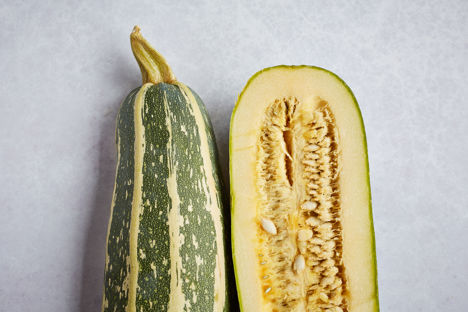Marrows are technically classed as a type of summer squash, though they're actually just very big courgettes. Left on the vine to grow larger, the skin is tougher and the flavour milder but the size makes it an excellent vessel for stuffing and the mild flesh carries punchy, spicy flavours wonderfully. If you grow your own vegetables then you'll no doubt have a glut of them in the later summer months of August and September, although they're readily available in shops around this time too. Their large size makes them perfect for midweek meals to fill up the family, but they're equally suited to show-stopping veggie roasts with a difference.
What to look for when buying a marrow
When selecting your marrow, the smaller the better, as very large ones tend to turn a little bitter and watery. Check the marrow is firm with no soft brown patches – although it’s such a large vegetable you can cut away any blemishes.
How to cook marrow
As with most vegetables, marrows can be roasted, steamed, baked, grilled or boiled. The skin can be quite tough (especially on larger marrows), so if you're not peeling it it’s a good idea to cut the vegetable into smaller pieces (although leaving it on when stuffing marrow is a good idea as it won't break down whilst cooking). Follow the recipe below for a simple roast marrow side dish.
Metric
Imperial
- 1 marrow
- 3 sprigs of fresh thyme
- olive oil
- salt
- pepper
Preheat the oven to 190ºC/gas mark 5
Slice the marrow in half lengthways and scrape out the seeds with a metal spoon
Slice the marrow into 1.5cm-thick crescents then toss with oil, salt and pepper. Place on a baking tray with the fresh thyme
Roast in the oven for around 25 minutes, mixing the marrow halfway through to get an even roast (and siphoning off any liquid which may have come out of the marrow during roasting)
To impart as much flavour as possible into the marrow, try stuffing with a rich, slow cooked stew, Bolognese, or moussaka then wrapping in foil and baking low and slow
The mild flesh of a marrow provides the perfect medium for strong flavours, so try cooking the flesh in a curry or tagine with plenty of punchy spices. You can also preserve the flavour all year round with a spiced chutney recipe.
The soft texture of marrow also lends itself well to creamy, cheesy textures with crunchy toppings; think pasta bakes or gratins. If you're feeling brave, try out this marrow and cheddar soufflé recipe from Anna Tobias.
Like carrots and courgettes, the water content in marrows makes for wonderfully moist baking; try savoury marrow, thyme and parmesan muffins, or go sweet with marrow, lemon and almond cupcakes.
Due to the size of this giant vegetable, why not turn to the marrow for party food inspiration? Marinate in miso then deep fry in tempura batter for a wonderfully crispy snack. Or experiment by charring the skin over a barbecue, then blend up the flesh with plenty of garlic, lemon and herbs for a twist on a smoky baba ganoush dip.
Get in touch
Please sign in or register to send a comment to Great British Chefs.



